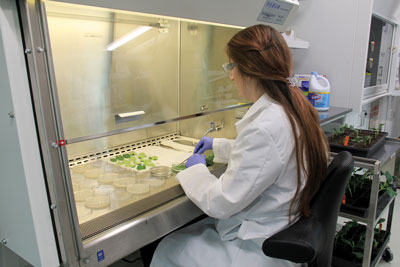10/1/2018
Valent Opens Biorational Research Center
Jennifer Zurko
Have you ever heard the term “biorational”? (Not “irrational,” like my 9 year old can be sometimes.) Simply, it means a pest-control product that’s safe for humans, animals and the environment. But what it specifically refers to is mimicking what happens in nature and applying it for the prevention of insects and diseases of food crops and plants. That’s what Valent BioSciences (a division of Valent USA) is looking to do with its biorational products.
In order to meet these goals, they’ve opened a new facility called the Biorational Research Center, located at the Lake County Innovation Park in Libertyville, Illinois. GrowerTalks was invited to attend the grand opening in early August to learn about the company’s plans for the facility and take tours through some of their labs and research areas.
 Pictured: In the plant pathology lab, they actually “grow” diseases to test new and existing products to see what works and what doesn’t. The new facility will give them more consistent results.
Pictured: In the plant pathology lab, they actually “grow” diseases to test new and existing products to see what works and what doesn’t. The new facility will give them more consistent results.
Valent USA President and CEO Andy Lee began the day by touching on the history of Valent, which was acquired by Japanese chemical company Sumitomo in the early 1990s, and their plans for the future. The BioSciences division was created in 2001 after Sumitomo acquired Abbot Laboratories, adding a line of PGRs, bioinsecticides and biorational products to their assortment.
Their main focus has always been in the agriculture sector, however, with the acquisition of Mycorrhizal Applications in 2015, Valent is now positioned to conduct research and develop products for the ornamentals greenhouse market. They’re also looking at hydroponics and indoor agriculture (which isn’t too much of a stretch from their current product lineup).
Andy said they recognize the industry is changing and consumers are driving that by demanding more transparency with what’s being applied to their food while it’s growing. Ray Nishimoto, head of Sumitomo’s Health & Crop Sciences and who made the trip from Japan for the center’s opening, agreed. “More important for the future is how we get to more sustainable practices,” he said.
The key function of the facility, at least in the beginning, will be a concentration on soil health. They will use “biorational tools” to help figure out how growers can get the best-quality crops with the highest yield using as few chemicals as possible. They’ll also be working on disease and pest management, and using the latest technology to figure out how to solve the problem of food waste.
We spent the afternoon touring 16 different research areas, including 4,400 sq. ft. of Nexus research greenhouses equipped with Argus climate controls. We also got an inside look inside their plant pathology and entomology/nematology labs, where their focus is on the prevention of vector-borne diseases and invasive insects.
“We’re intensely serious about protecting the food chain, from seed to salad, because we’re always under attack,” said Dr. Deanna Branscome, Crop Protection Research Manager. GT